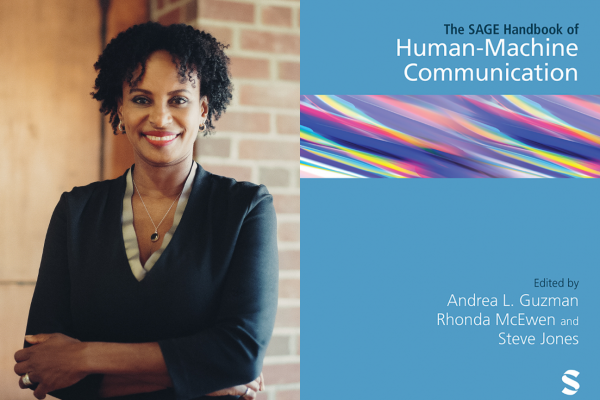New Book Explores Implications of Machines Performing ‘Human’ Roles

"How will people working within a group react to the presence of a robot or AI that is also collaborating with them?” asks Dr. Rhonda N. McEwen in a new book she co-edited.
By Joe Howell
“We hear so much about the emerging technologies impacting our lives and reshaping our world,” says Dr. Rhonda N. McEwen, president and vice-chancellor of Victoria University in the University of Toronto. “Artificial intelligence (AI), robots, ChatGPT, virtual assistants like Siri and Alexa—the list goes on. But until now there has been no established canon, no single resource that researchers, scholars, educators, even people in business and journalism could turn to that studies the issues from multiple angles.”
The SAGE Handbook of Human–Machine Communication, a new book co-edited by McEwen, Andrea L. Guzman and Steve Jones, seeks to address this need. The trio first discussed creating a foundational text in 2018 at the Association of Internet Researchers’ (AoIR) annual conference, later determining to “cast nets as far globally and as wide disciplinarily as we could” to entice authors to sign on to their vision. The resulting work is a comprehensive reference book that surveys the methods, debates, theories and more contributing to the rapidly emerging field of human-machine communication (HMC).
The book also serves as a detailed snapshot capturing this pivotal moment in history. “Now we have the idea that we’re in communication with these AIs, versus thinking of them as tools—yet the phrase ‘human-machine communication’ didn’t even exist a few years ago,” notes McEwen. Suddenly, the concept is pervasive, with implications and use cases for virtually every sphere of human activity. That’s why McEwen and her co-editors strove for a remarkable range of subject-matter expertise in their contributors.
“We have writers coming in from art history, we have people looking at space exploration, we have a great piece on how AIs interact with labour. We have sections on manufacturing, marketing and retail; we even have a chapter on war,” says McEwen. “We broadened the scope to make it a truly global book. We really hope that we will get people to step out of their silo boxes a little bit, and listen to and engage with people who are thinking about the same technologies—but from another viewpoint entirely.”
One of the goals of the book is to have the authors read and consider each other’s work, says McEwen, so they may return to the spaces where they research and teach with new ideas and perspectives. For her part, that space is the Emerging Technologies and the Arts Lab (ETAL) at Victoria University, where she works with Vic College undergraduates, graduate students from across U of T, and post-doctoral fellows with the Institute of Communication, Culture, Information and Technology (ICCIT).
“Someone who’s looking at, say, human-robot interaction may not be thinking about gender from a feminist theory perspective—and vice versa,” McEwen says. “Having read all 65 chapters multiple times, I can tell you some are actually in healthy tension with others. We’re good with that, if the writers can explain why they’re putting forward an alternative view. This all makes for better conceptualization, theory, development, policy—and better technologies.”
Learn more about The SAGE Handbook of Human–Machine Communication.
About Rhonda N. McEwen
Dr. McEwen is Victoria University’s 14th president and vice-chancellor. Born in Trinidad and Tobago, she completed a Bachelor of Science from the University of the West Indies, an MBA in information technology, a Master of Science in telecommunications, and a PhD from the University of Toronto’s Faculty of Information. Dr. McEwen served as director of the Institute of Communication, Culture, Information & Technology (ICCIT) at UTM, and is a Canada Research Chair in Tactile Interfaces, Communication and Cognition. She co-authored the peer-reviewed book Understanding Tablets from Early Childhood to Adulthood, and her research has been shared in more than 47 peer-reviewed journal articles, conference proceedings and books.
About Victoria University in the University of Toronto
Victoria University, federated with the University of Toronto, was founded in 1836 and is one of the oldest universities in Canada. As a recognized leader in undergraduate education in the arts and sciences and in graduate education in theology, Victoria University creates an environment where students discover how to match their distinctive talents to some of the world's most pressing issues. It is home to two outstanding colleges. Victoria College—with its small class sizes, its distinctive first-year programs, and its exceptional students—is recognized as one of the most rewarding places in Canada to pursue an undergraduate education. Emmanuel College prepares students from many faiths and backgrounds for leadership roles in religious contexts. The iconic campus is located on the east side of Queen’s Park, south of Bloor Street, in Toronto.
